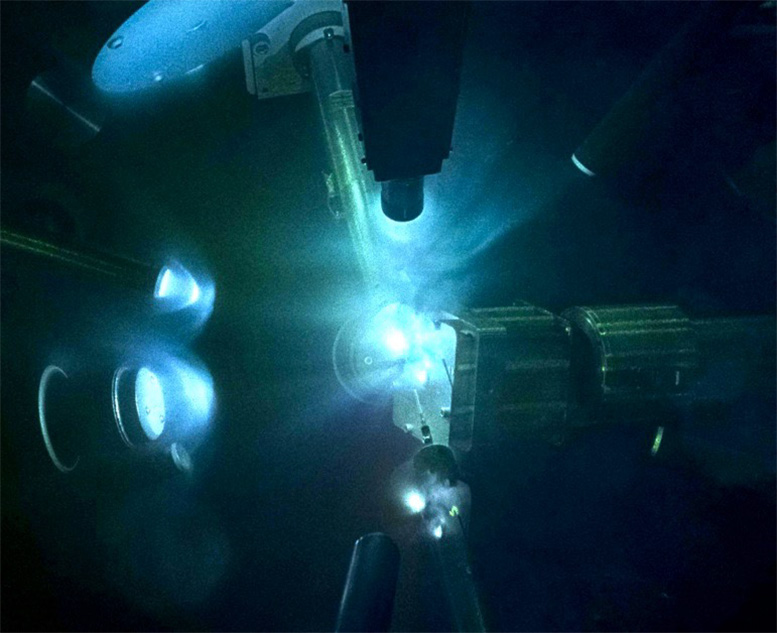Scientists Uncover First Building Block in Super-Earth Formation


Researchers have shown through high-energy laser experiments that magnesium oxide is likely the first mineral to solidify in super-Earth formation, crucially impacting these planets’ geophysical evolution.
A new study reveals that magnesium oxide, a key mineral in planet formation, might be the first to solidify in developing “super-Earth” exoplanets, with its behavior under extreme conditions significantly influencing planetary development.
Scientists have for the first time observed how atoms in magnesium oxide morph and melt under ultra-harsh conditions, providing new insights into this key mineral within Earth’s mantle that is known to influence planet formation.
High-energy laser experiments—which subjected tiny crystals of the mineral to the type of heat and pressure found deep inside a rocky planet’s mantle—suggest the compound could be the earliest mineral to solidify out of magma oceans in forming “super-Earth” exoplanets.
“Magnesium oxide could be the most important solid controlling the thermodynamics of young super-Earths,” said June Wicks, an assistant professor of Earth and Planetary Sciences at Johns Hopkins University who led the research. “If it has this very high melting temperature, it would be the first solid to crystallize when a hot, rocky planet starts to cool down and its interior separates into a core and a mantle.”
Implications for Young Planets
The findings are newly published in Science Advances.
They suggest that the way magnesium oxide transitions from one form to another could have important implications for the factors that control whether a young planet will be a snowball or a molten rock, develop water oceans or atmospheres, or have a mixture of those features.
“In terrestrial super-Earths, where this material is going to be a big component of the mantle, its transformation is going to contribute significantly to how quickly heat moves in the interior, which is going to control how the interior and the rest of the planet form and deform over time,” Wicks said. “We can think of this as a proxy for interiors of these planets, because it’s going to be the material that controls its deformation, one of the most important building blocks of rocky planets.”

View of laser-driven experiments of shock-compressed magnesium oxide (MgO) within the chamber at the Laboratory for Laser Energetics. High-power laser beams are used to compress MgO samples to pressures beyond those found in the center of Earth. A secondary source of X-rays is used to probe MgO’s crystal structure. Brighter regions are glowing plasma emission over nanosecond timescales. Credit: June Wicks/Johns Hopkins University
Larger than Earth but smaller than giants like Neptune or Uranus, super-Earths are key targets in exoplanet searches because they are commonly found among other solar systems in the galaxy. While the composition of these planets can vary from gas to ice or water, rocky super-Earths are expected to contain significant amounts of magnesium oxide that can influence the planet’s magnetic field, volcanism, and other key geophysics like they do on Earth, Wicks said.
To mimic the extreme conditions this mineral might sustain during planet formation, Wick’s team subjected small samples to ultra-high pressures using the Omega-EP laser facility at the University of Rochester’s Laboratory for Laser Energetics. The scientists also shot X-rays and recorded how those light rays bounced off the crystals to track how their atoms rearranged in response to the increasing pressures, specifically noting at what point they transformed from a solid to a liquid.
When squeezed extremely hard, the atoms of materials like magnesium oxide change their arrangement to sustain the crushing pressures. That’s why the mineral transitions from a rock salt “phase” resembling table salt to a different configuration like that of another salt called cesium chloride as pressure increases. This makes for a transformation that can affect a mineral’s viscosity and impact on a planet as it comes of age, Wicks said.
Stability of Magnesium Oxide at High Pressures
The team’s results show that magnesium oxide can exist in both of its phases at pressures ranging from 430 to 500 gigapascals and temperatures of around 9,700 Kelvin, nearly twice as hot as the surface of the sun. The experiments also show that the highest pressures the mineral can withstand before melting completely are upward of 600 gigapascals, about 600 times the pressure one would feel in the deepest trenches of the ocean.
“Magnesium oxide melts at a much higher temperature than any other material or mineral. Diamonds may be the hardest materials, but this is what will melt last,” Wicks said. “When it comes to extreme materials in young planets, magnesium oxide is likely going to be solid, whereas everything else that will be hanging out down there in the mantle is going to be turned to liquid.”
The study showcases the stability and simplicity of magnesium oxide under extreme pressures and could help scientists develop more accurate theoretical models to probe key questions about the behavior of this and other minerals within rocky worlds like Earth, Wicks said.
“The study is a love letter to magnesium oxide, because it’s amazing that it has the highest temperature melting point that we know of—at pressures beyond the center of Earth—and it still behaves like a regular salt,” Wicks said. “It’s just a beautiful, simple salt, even at these record pressures and temperatures.”
Reference: “B1-B2 transition in shock-compressed MgO” by June K. Wicks, Saransh Singh, Marius Millot, Dayne E. Fratanduono, Federica Coppari, Martin G. Gorman, Zixuan Ye, J. Ryan Rygg, Anirudh Hari, Jon H. Eggert, Thomas S. Duffy and Raymond F. Smith, 7 June 2024, Science Advances.
DOI: 10.1126/sciadv.adk0306
Other authors are Saransh Singh, Marius Millot, Dayne E. Fratanduono, Federica Coppari, Martin G. Gorman, Jon H. Eggert, and Raymond F. Smith of Lawrence Livermore National Laboratory; Zixuan Ye and Anirudh Hari of Johns Hopkins University; J. Ryan Rygg of the University of Rochester; and Thomas S. Duffy of Princeton University.
This research was supported by NNSA through the National Laser Users’ Facility Program under contract Nos. DE-NA0002154 and DE-NA0002720 and the Laboratory Directed Research and Development Program at LLNL (project No. 15-ERD-012). This work was performed under the auspices of the U.S. Department of Energy by Lawrence Livermore National Laboratory under contract No. DE-AC52-07NA27344. The research was supported by National Nuclear Security Administration through the National Laser Users’ Facility Program (contract Nos. DE-NA0002154 and DE-NA0002720) and the Laboratory Directed Research and Development Program at LLNL (project Nos. 15-ERD-014, 17-ERD-014, and 20-ERD-044).

